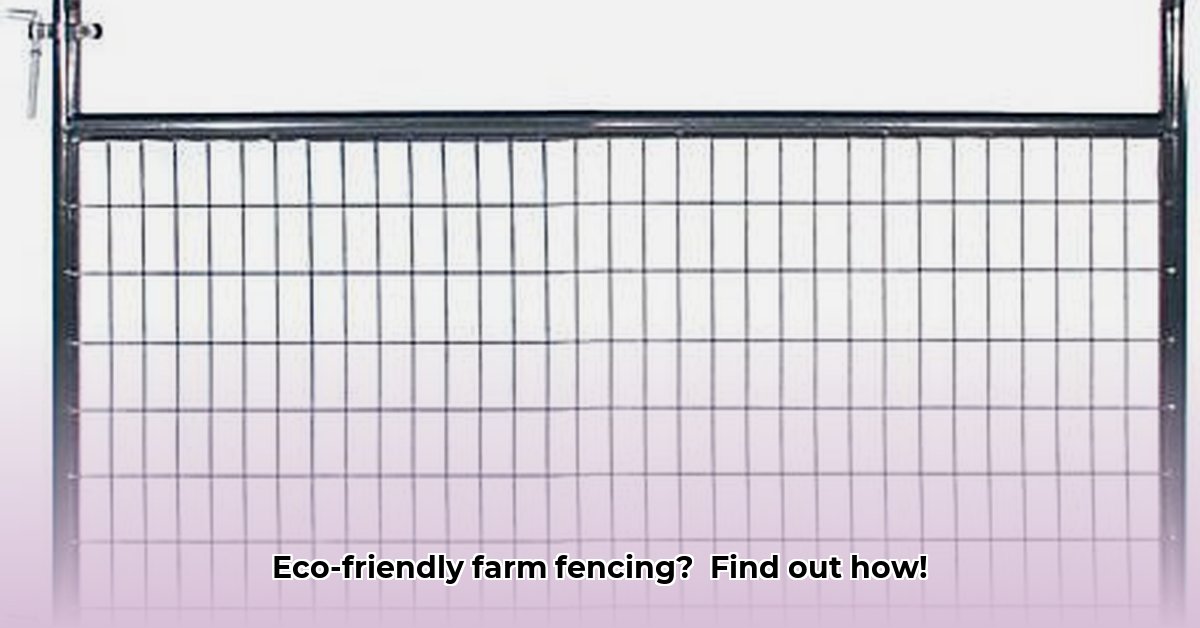
Good fencing is crucial for any successful farm, and choosing the right gate can significantly impact both efficiency and environmental sustainability. This guide focuses on Tractor Supply's 6-foot gate, covering installation, maintenance, sustainable alternatives, and its integration into eco-conscious farming practices. For smaller projects, consider alternatives like this wire fence.
Getting to Know Your Tractor Supply 6-Foot Gate
Tractor Supply offers 6-foot gates in various materials, typically treated pine wood or steel. Prices vary depending on material and features. Steel gates, while more expensive upfront, offer superior durability and longevity, potentially saving money in the long run. Treated pine, while more affordable initially, requires regular maintenance and has a shorter lifespan. Choosing the right material depends on your budget, desired durability, and overall farming goals. What factors are most important to you when considering a new gate?
Installing Your New Gate: A Step-by-Step Guide
Installing your gate correctly ensures its longevity and functionality. Follow these steps for optimal results:
- Prepare the Site: Ensure level ground and firmly set fence posts using concrete for maximum stability. Proper post placement is critical for preventing sagging and ensuring the gate remains secure. A poorly installed gate can require significant repairs later.
- Hang the Hinges: Attach hinges securely to both the gate and the posts. Use high-quality hardware appropriate for the gate material. This prevents squeaks and wobbles down the road.
- Install the Gate: Carefully lift and hang the gate onto the hinges, double-checking for levelness and alignment. A misaligned gate can lead to premature wear and tear.
- Secure the Latch: Install the chosen latch mechanism, ensuring a secure and smooth operation. A reliable latch is crucial for safety and efficiency and minimizing livestock escapes. Consider the level of security needed.
- Final Inspection: Thoroughly test the gate's functionality, checking for smooth operation and secure closure. Now is the time to correct any issues before they become problems.
Keeping Your Gate in Top Shape: Maintenance Made Easy
Regular maintenance significantly extends your gate's lifespan.
- Cleaning: Regularly remove mud, debris and dirt to prevent rust on metal gates and wood rot on wooden gates. A simple cleaning can dramatically reduce long-term damage.
- Inspection: Periodically check hinges, latches, and the frame for wear and tear, tightening any loose screws or bolts. Early detection of issues minimizes costly repairs.
- Repairing Damage: Address minor damage immediately. A small crack or loose hinge is easier and cheaper to fix than a larger, neglected problem. Ignoring small issues always costs more in the long run.
- Protection (Wood Gates): Apply a fresh coat of paint or sealant to protect wood from the elements and extend its longevity. This yearly maintenance is a small investment that pays off in prolonged gate life.
Thinking Green: Sustainable Options Beyond Tractor Supply
While the Tractor Supply gate is convenient, exploring sustainable alternatives is essential for environmentally conscious farming.
| Material | Pros | Cons | Sustainability Rating |
|---|---|---|---|
| Treated Pine | Readily available, relatively inexpensive | Requires chemical treatment; limited lifespan; disposal issues | Moderate |
| Metal (Steel) | Durable, long-lasting; recyclable | Energy-intensive manufacturing; potential for rust; specific disposal needs | Moderate |
| Bamboo | Rapidly renewable; strong and durable; aesthetically pleasing | Less widely available; specialized hardware might be needed; pest susceptibility | High |
| Recycled Materials | Environmentally friendly; reduces landfill waste | Durability can vary; may be more expensive; limited availability | High |
Choosing sustainable materials directly impacts your farm's environmental footprint. Dr. Emily Carter, Professor of Chemical and Biomolecular Engineering at Princeton University, emphasizes the importance of lifecycle analysis "to truly understand the environmental impact of any material."
Integrating Your Gate into Your Sustainable Farming Practices
Proper fencing, including your gate, is vital for several sustainable farming practices. Rotational grazing, for example, increases soil health and reduces overgrazing. Strategic fencing also protects water sources and keeps livestock out of sensitive areas. How does your fencing strategy contribute to your farm's overall efficiency and sustainability goals?
Responsible Disposal: End of Life for Your Gate
When your gate reaches the end of its lifespan, responsible disposal is crucial. Check local regulations for recycling options for wood and metal. Avoid simply discarding it; proper disposal protects the environment. What are the most environmentally sound practices near you?
Key Takeaways: Sustainable Fencing for Small Farms
- Material choice significantly impacts both initial cost and long-term maintenance.
- Proper installation and regular maintenance extend the gate's lifespan.
- Exploring sustainable alternatives can reduce environmental impact.
- Integrating sustainable fencing practices enhances farm efficiency and environmental stewardship.
This guide serves as a starting point for implementing sustainable fencing practices on your farm. By carefully considering materials, installation, maintenance, and long-term sustainability, you can make informed choices that benefit both your farm's productivity and the environment.